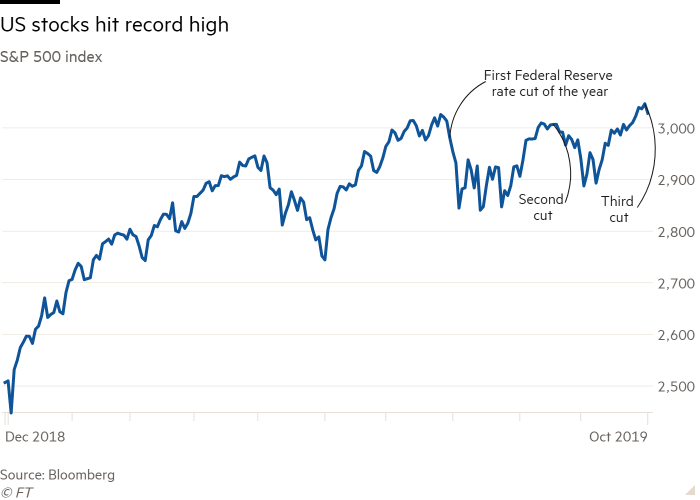Fed rate cuts and buybacks have provided support to equities
Richard Henderson and Jennifer Ablan in New York

Persistent stock buybacks have supported prices © AFP
As Jared Woodard, a Bank of America investment strategist, steps into the elevator at work each morning in Midtown Manhattan, he already knows what investors will call to ask.
Why has the US stock market hit record highs while investor confidence, reacting to a worsening economic outlook, has deteriorated?
“It’s the most frequently asked question we’ve had this year,” Mr Woodard said. “Investors we speak to are incredibly cautious. They see the market rally but they don’t trust it.”
US economic growth slowed in the third quarter as business investment continued to weaken, adding to concerns the global economy rests on a knife-edge. But the S&P 500 hit a record high this week, capping a 20 per cent rise this year. If this performance holds until the end of December, it would mark one of the best annual returns since the financial crisis.
Other market indicators seem more responsive to the economic picture. The closely monitored yield curve of US government debt inverted earlier this year, a haunting sign that has foreshadowed recessions over the past five decades, and a capital squeeze in the market for overnight bank lending has caught the Federal Reserve off-guard, forcing it to inject billions of dollars of liquidity.
Nervous investors have continued to rush to their favourite retreats, including cash and low-risk bonds, sending yields plummeting. This has swelled the universe of negatively yielding debt to $13.5tn. “It’s hard to think of a better measure of pessimism about global growth,” Mr Woodard said.
Set against the gloomy economic picture, the US stock market’s meteoric rise is “a fantastic dichotomy”, said Mr Woodard.

A series of rate cuts by the Fed — including a quarter percentage point cut on Wednesday, the third this year — and cautious optimism that the US and China will resolve the trade stand-off have pushed stocks higher.
The Fed’s decision to increase temporary liquidity injections to $120bn a day from the current $75bn have also added further support for stocks, said Nick Maroutsos, co-head of global bonds at asset manager Janus Henderson.
The stock market has a record of pricing in today what will happen to the economy in the near future. But given the weak growth outlook, this pattern is being called into question, said Alessio de Longis, a senior portfolio manager on the multi-asset investing team at fund manager Invesco. “There is a disconnect between where the market is going and where the economy is heading,” Mr de Longis said.
On this reading, investors should look instead to the bond market to understand why stocks continue to climb. The debt market, highly sensitive to bad news, has been raising red flags about slowing domestic and international growth as reflected in sliding yields.
Major central banks responded quickly to the deteriorating economic outlook with aggressive monetary policy action in the form of interest-rate cuts and bond-buying. This seems to have reassured investors. “We hit a bottom in global yields over the summer and since then they’ve moved up, suggesting the fears of a global recession have eased,” said Alicia Levine, chief market strategist for BNY Mellon Investment Management.
Yields on Japanese, German and Chinese government debt have inched higher since the summer, as investors have sold safe bonds in favour of riskier assets like equities. “Everyone was really negative and the most crowded trade was the safety trade,” she said. Analysts now think this trend is reversing.

Corporate activity is another part of the puzzle. US corporate profits contracted in the first and second quarters of the year, sending them into an “earnings recession”, according to FactSet data. It expects this trend to continue into the third quarter.
Balancing that, stock buybacks — where a company repurchases its own shares — continue to provide support to the stock market. When companies buy their own stock, they reduce the total amount of shares on the market, inflating common metrics like earnings per share, which typically boosts the stock price.
Last year, companies in the S&P 500 spent a record $806bn buying back shares. Activity this year has slowed slightly, but remains on track to be one of the most active on record. In the third quarter alone, companies are expected to spend around $170bn on their own stock, according to data compiled by Howard Silverblatt, senior index analyst for S&P Dow Jones Indices. “Whether it’s good or bad, the market has gotten used to buybacks,” Mr Silverblatt said.
Apple, which consistently ranks among the most active companies to buy its own stock, spent almost $18bn on buybacks in the third quarter, in line with prior quarters.
Persistent stock buybacks combined with the upbeat tone on trade negotiations between the US and China and historically low rates in the US are likely to keep stocks elevated, said BofA’s Mr Woodard.
Investors who have sat on the sidelines will begin to grow anxious that stocks will just keep rising, he added. “When the market reaches new highs there is a ‘fear of missing out’ trade,” he said. Fresh all-time highs would suggest that this “FOMO trade” is in effect.
0 comments:
Publicar un comentario